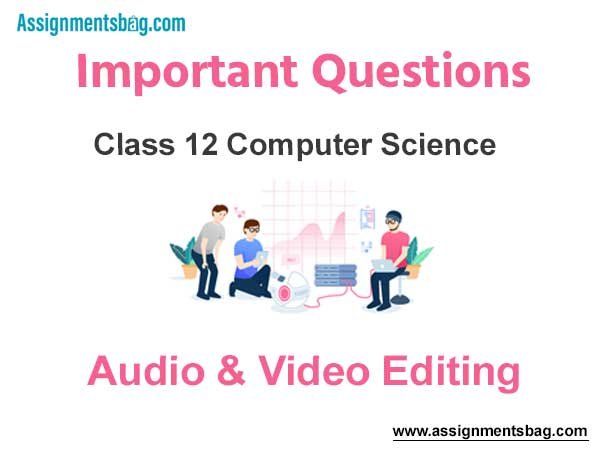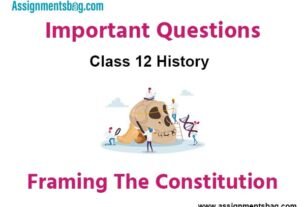Please refer to Audio & Video Editing Class 12 Computer Science Important Questions with solutions provided below. These questions and answers have been provided for Class 12 Computer science based on the latest syllabus and examination guidelines issued by CBSE, NCERT, and KVS. Students should learn these problem solutions as it will help them to gain more marks in examinations. We have provided Important Questions for Class 12 Computer Science for all chapters in your book. These Board exam questions have been designed by expert teachers of Standard 12.
Class 12 Computer Science Important Questions Audio & Video Editing
Short Answer Type Questions:
Questions: Write the names of the three stages of making a movie.
Ans: The task of making a movie is usually divided into three stages:
• PRE-PRODUCTION: It is the initial stage. At this stage, the script of the movie is written, the people working are organized and then the shots are planned.
• PRODUCTION: This stage involves shooting of video.
• POST-PRODUCTION: This stage involves video editing, audio editing, and special effects to a movie using video editing software.
Questions: Write down the names of some video editing software.
Ans: The following are some of the popular video editing software:
• For Windows operating systems: Filmora Pro, Windows Movie Maker, Adobe Premiere Pro CC
• For Android (ANDROID) operating system: Adobe Premiere Pro, KineMaster, Viva Video
Questions: What is cd ripping?
Ans: Audio CDs store audio files as tracks. These audio CDs can be played directly on Home Theatres, HIFI Audio Systems etc. But we cannot copy/paste these tracks and save them on computer. The process of copying these tracks and storing them in computer playable file formats (such as MP3, WAV, etc.) is called CD ripping. For this we need special software that provides CD ripping facility.
Questions: What are codecs?
Ans: A codec is a file or program used to Compress and Decompress a digital media file. The codec can be divided into two parts: Encoder and Decoder. The Encoder compresses the media and the decoder decodes it. Some codecs contain both of these components and some codecs contain only one of them. For example: When a song is Riped from an audio CD to a computer, Windows Media Player compress the song in the .WMA (Windows Media Access) format by default using the audio codec. When the .WMA file is played, Windows Media Player decompress the file using the audio codec to play the audio properly.
Questions: What is video split?
Ans: Sometimes we need to remove unwanted part of a video from the beginning or end of the video or we need to delete a part of the video in between. Video cutting is the process of changing the length of a video as required. Here are some keywords related to video cutting:
• TRIM: Using trim operation, we can remove a part of the video from the beginning or end.
• Cut: It means to cut a part of a video clip.
• Split: When a long video is divided into smaller parts, this process is called splitting the video.
Long Answer Type Questions.
Questions: How Export Video is different from the Save Project.
Ans: The project is exported after the video editing work is finished. This is the last step in making a
final video. The project is exported to create the Final Movie file. In Export Settings, we can choose Video Resolution, Quality, Format and Encoderm options. After exporting, we can play our movie on computer, mobile etc.
Saving a project is different from exporting a project. Saving the project does not create the final movie but the work done in the project is stored on disk. While working on the project, we should keep saving our project regularly after short intervals. We can reopen the saved project at any time and continue our work in it. The option to save the project is usually found in the “File” menu of the software.
Questions: What are Tracks?
Ans: When we Import a video in Video Editing Software and insert it into the tracks, the video is divided into two parts: Visual and Audio. The visual part contains only video (without sound) and the audio part contains only sound. These video and audio sections are housed in separate video and audio tracks, where we can edit them. All video editing software provides separate tracks for audio and video and we can add as many tracks as we need. Tracks are very useful when we need to edit a specific part of an audio / video. It is not possible to put two clips on the same track at same place. If we want to include audio as well as our video, we still need to use more than one track.
Questions: Explain the difference between Video Transitions and Video Effects.
Ans: Video transitions are the effects applied to a video. These effects are applied between two objects. A video transition controls how another video or picture will be displayed after one video clip or picture has been played in the movie. We can apply transition effects between two images, video clips or titles. Storyboards or timelines are used to insert transition effects. This transition takes place after one clip is finished and before the next clip starts. We can also set the transition time according to our requirements.
Questions: Write about the Audio Converter in detail.
Ans: There are many audio file formats that can be used on a computer or other device. Each format may be better than the other. MP3 (MPEG Audio Layer 3) format is a common audio format that is widely played on electronic devices. The software used to convert an audio file format to another audio format is called an audio converter. These softwares require codecs to complete this conversion. Some of the popular audio converter software are: Xilisoft Audio Converter, Switch Audio Converter, Ashampoo Music Studio, Format Factory, Freemake Audio Converter and Fre: ac etc.
Questions: Write in more detail: Storyboard, Timeline, Titles.
Ans: Storyboard, Timeline and Titles can be explained as follows:
• Storyboard: This is a panel of pictures or other video clips to create the story of the movie. It shows the sequence of photos and video clips that will appear in the movie. We can re-arrange pictures or videos by placing them in the storyboard. It also shows transition effects.
• Timeline: This is used to edit the timing of clips in our project. Audio clips included in the movie project are not displayed on the storyboard. They can be viewed in the timeline panel. In the timeline view, we can trim the clips. It can also include tracks as needed.
• Titles: Titles help us to enhance our movie by adding text-based captions to the movie. We can add titles to the movie to show any kind of information, such as movie name, movie release date, cast names, etc. We can also apply animation effects to the titles to make the movie more attractive.



